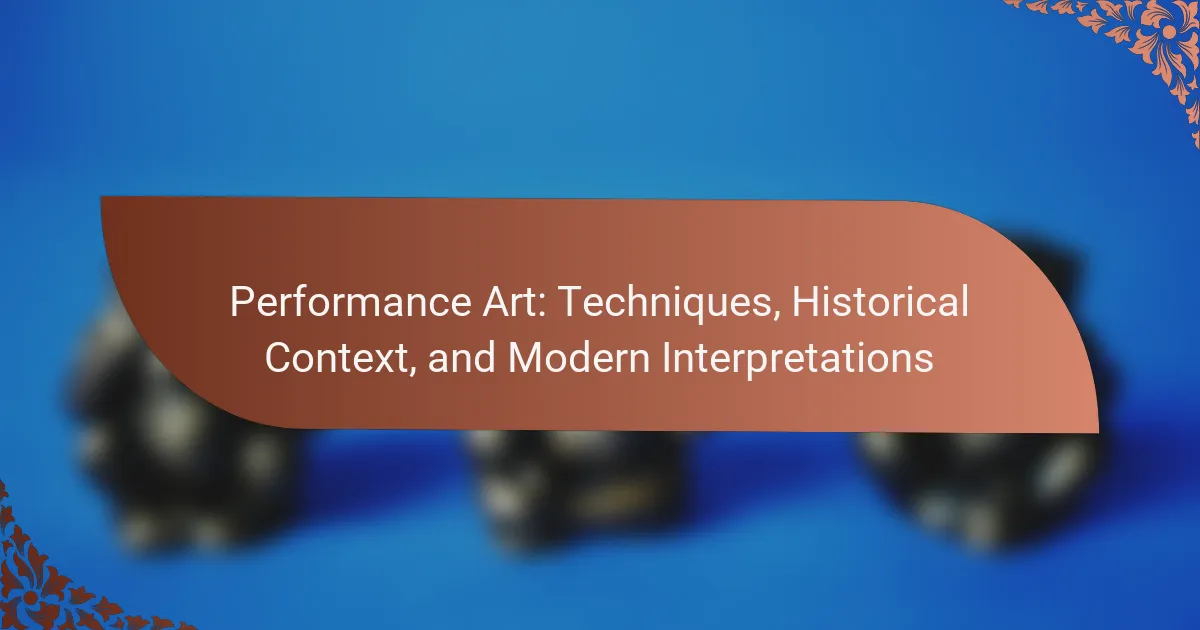Performance art captivates audiences through its unique techniques and emotional expression. This article explores foundational techniques like body movement and improvisation, traces its historical evolution from avant-garde roots to modern interpretations, and examines contemporary trends emphasizing interactivity and social engagement. Additionally, it highlights regional variations and the challenges faced by performance artists today.
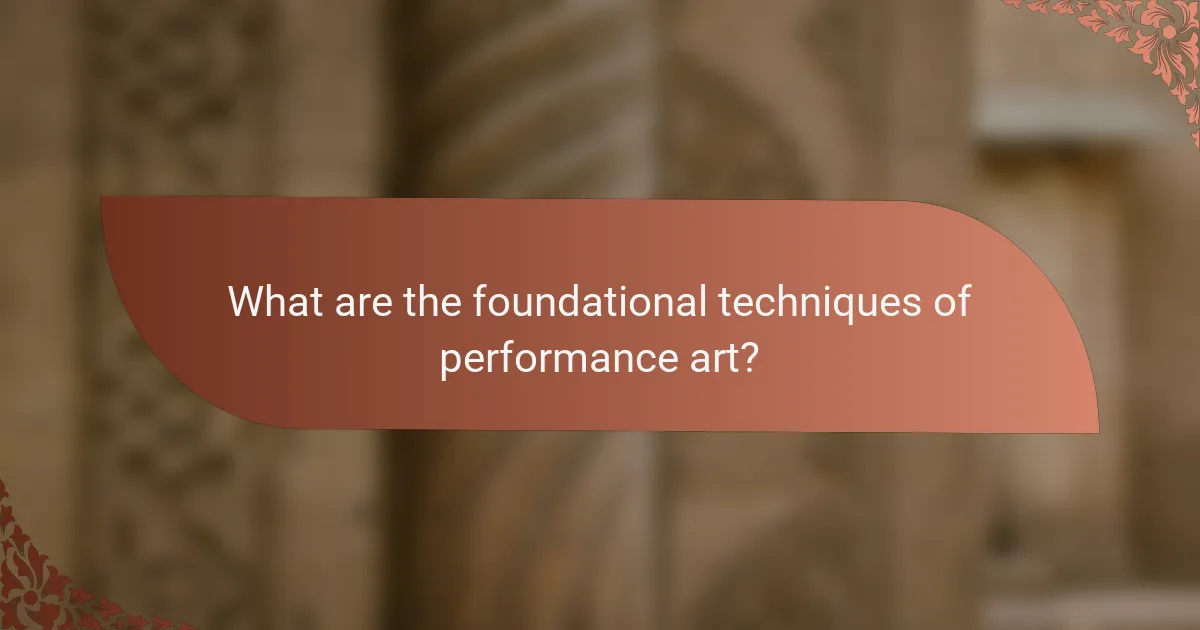
What are the foundational techniques of performance art?
Foundational techniques of performance art include body movement, improvisation, audience interaction, and the use of space. These techniques emphasize the artist’s physical presence and emotional expression. Body movement is essential for conveying messages and emotions. Improvisation allows for spontaneity and adaptability during performances. Audience interaction creates a shared experience, enhancing engagement. The use of space involves manipulating the environment to influence the performance’s impact. These techniques collectively shape the essence of performance art, allowing for diverse interpretations and experiences.
How do movement and physicality influence performance art?
Movement and physicality significantly enhance performance art by expressing emotion and engaging the audience. The physical presence of the artist creates a dynamic interaction, transforming abstract concepts into tangible experiences. For instance, the use of gestures and body language can convey complex narratives, allowing deeper emotional connections.
Moreover, the historical evolution of performance art showcases how different movements have influenced techniques. In the 1960s, artists like Marina Abramović utilized endurance and physical challenges to explore the limits of the body, emphasizing vulnerability and strength. This unique approach to physicality continues to inspire modern interpretations, where movement remains a core element in conveying themes and messages.
As a result, the integration of movement in performance art is not merely aesthetic; it serves as a foundational attribute that shapes the overall impact and meaning of the work. This interplay between body and expression fosters a unique dialogue with the audience, enhancing the immersive experience of performance art.
What role does audience interaction play in performance art?
Audience interaction is crucial in performance art as it shapes the experience and meaning of the work. Engaging the audience transforms them from passive observers into active participants, influencing the performance’s dynamics. This interaction can take various forms, such as improvisation, direct communication, or audience-driven decisions.
Historically, performance art has relied on audience feedback to create a shared space for exploration and dialogue. Modern interpretations often emphasize this relationship, reflecting societal issues and personal narratives that resonate with viewers. Unique attributes of performance art, such as spontaneity and emotional exchange, are enhanced through audience involvement, fostering a deeper connection and understanding of the art form.
Which elements of visual art are commonly integrated into performance art?
Performance art often integrates elements of visual art such as painting, sculpture, and installation. These elements enhance the sensory experience and convey deeper meanings. For example, live painting can create a dynamic visual narrative, while sculptural props can provide physical context. Additionally, the use of space in performance art draws from installation techniques, allowing for immersive environments. This fusion enriches the audience’s engagement and interpretation of the performance.
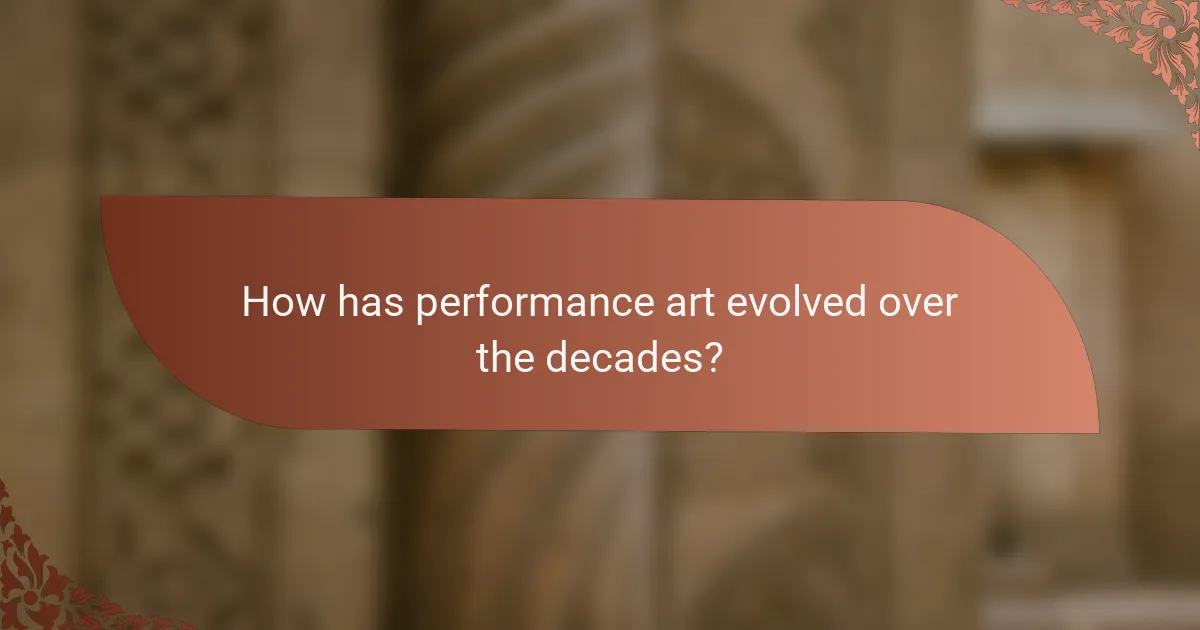
How has performance art evolved over the decades?
Performance art has evolved significantly, reflecting cultural shifts and technological advancements. Initially rooted in avant-garde movements of the early 20th century, it gained prominence in the 1960s and 1970s, emphasizing spontaneity and audience interaction.
In the 1980s and 1990s, performance art began incorporating multimedia elements, expanding its reach and impact. Artists like Marina Abramović pushed boundaries, exploring endurance and vulnerability. The rise of digital technology in the 2000s introduced new platforms for performance, allowing for virtual experiences and broader audiences.
Today, performance art often includes social commentary, addressing issues like identity, politics, and environmental concerns. This evolution reflects a unique attribute of performance art: its adaptability to contemporary issues while maintaining its core focus on the live experience.
What were the defining moments in the history of performance art?
Performance art has evolved through several defining moments that shaped its trajectory. Key events include the Dada movement’s anti-art stance in the early 20th century, which challenged traditional forms. The 1960s saw artists like Marina Abramović and Yoko Ono push boundaries, emphasizing the body as a medium. The rise of documentation in the 1970s allowed performances to reach wider audiences through video and photography. In contemporary practice, digital technology and social media have transformed how performance art is created and shared, making it more accessible and interactive.
How do cultural contexts shape the interpretation of performance art?
Cultural contexts significantly influence how performance art is interpreted. They shape audience perceptions, emotional responses, and the intended message of the artwork.
Cultural backgrounds affect the symbols and references used in performance art. For instance, a performance rooted in a specific cultural tradition may resonate differently with audiences unfamiliar with that context.
Historical events and societal norms also play a crucial role in interpretation. Performance art that addresses contemporary issues may evoke varied reactions depending on the cultural lens through which it is viewed.
In modern interpretations, globalization introduces new dynamics. Artists often blend diverse cultural elements, leading to hybrid forms that challenge traditional interpretations and invite broader engagement.
Which influential performance artists have shaped the genre?
Key performance artists who have shaped the genre include Marina Abramović, Yoko Ono, and Chris Burden. Marina Abramović is known for her endurance-based works that explore the relationship between performer and audience. Yoko Ono’s conceptual pieces emphasize participation and audience engagement. Chris Burden’s provocative performances often challenge societal norms and perceptions of art. These artists have contributed to the evolution of performance art through unique approaches and themes.

What are the contemporary trends in performance art?
Contemporary trends in performance art emphasize interactivity, technology integration, and social engagement. Artists increasingly use multimedia elements to enhance audience participation. Additionally, themes of identity, politics, and environmental issues dominate modern performances. This evolution reflects a shift towards inclusivity and collaboration in the art form.
How is technology transforming performance art in 2025?
Technology is revolutionizing performance art in 2025 by integrating immersive experiences and digital tools. Artists now utilize augmented reality to enhance storytelling, creating interactive environments. Virtual reality enables audiences to engage in new dimensions of performance, blurring the line between performer and viewer. Additionally, artificial intelligence assists in generating dynamic content, offering unique compositions tailored to audience reactions. These innovations foster collaboration across disciplines, expanding the creative possibilities within performance art.
Which themes are prevalent in modern performance art?
Modern performance art features themes of identity, social commentary, and audience interaction. Artists often explore personal narratives, cultural critique, and political issues, reflecting contemporary societal challenges. Unique attributes include the use of technology and multimedia, which enhance engagement and broaden the scope of expression. Rare themes such as environmental concerns and mental health awareness are emerging, showcasing the evolving nature of performance art in response to global issues.
What impact does social media have on the dissemination of performance art?
Social media significantly enhances the dissemination of performance art by broadening audience reach and fostering engagement. Artists utilize platforms like Instagram and TikTok to showcase their work, attracting diverse viewers globally. This immediate access allows for real-time feedback and interaction, which traditional venues often lack. Additionally, social media democratizes performance art, enabling emerging artists to gain visibility without gatekeeping. As a result, the impact of social media on performance art is transformative, facilitating a new era of accessibility and community building.
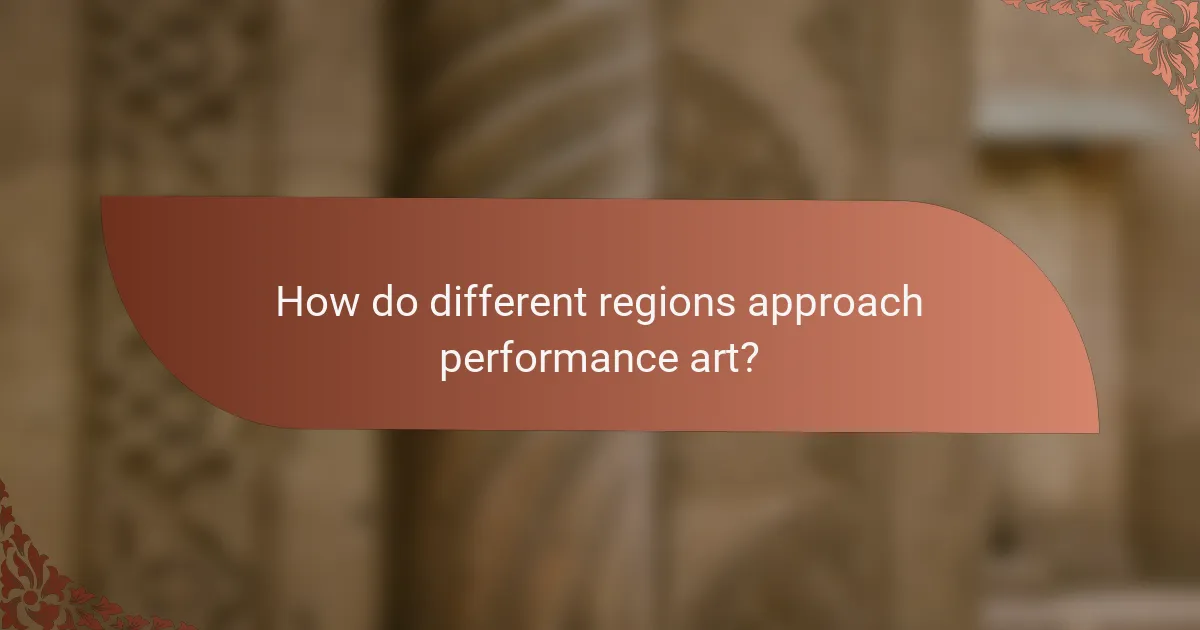
How do different regions approach performance art?
Different regions approach performance art through diverse cultural lenses, resulting in unique expressions and techniques. In Europe, performance art often emphasizes conceptual frameworks and critiques of society. For instance, the Dada movement in Switzerland and the Fluxus movement in Germany challenged traditional art forms. In contrast, Asian performance art frequently integrates traditional rituals and storytelling, exemplified by Japanese Noh theater and Chinese opera.
North America showcases a blend of influences, with artists using performance to address social issues and identity politics. The feminist performance art movement, for example, gained traction in the 1970s, focusing on women’s rights and representation. Latin American performance art reflects the region’s political history, often incorporating elements of resistance and cultural heritage.
In Africa, performance art is rooted in community and ritual, with traditional dance and storytelling playing vital roles in cultural preservation. Contemporary artists blend these traditions with modern themes, creating a dynamic dialogue between past and present. Each region’s approach to performance art reveals the rich tapestry of cultural identity and societal values.
What unique characteristics define performance art in North America?
Performance art in North America is characterized by its emphasis on spontaneity, audience interaction, and a blend of various artistic disciplines. Unique traits include the use of personal narratives and social commentary to challenge cultural norms. Influential figures like Marina Abramović and Yoko Ono exemplify these characteristics through their provocative performances. Additionally, the integration of technology and multimedia elements has become a rare attribute of contemporary performance art, enhancing the immersive experience for audiences.
How does European performance art differ from its North American counterpart?
European performance art often emphasizes collective experiences and social commentary, while North American performance art tends to focus on individual expression and personal narratives. This fundamental difference stems from distinct historical contexts and cultural influences in each region. European performance art frequently incorporates political themes, reflecting its historical engagement with social movements. In contrast, North American performance art often showcases diverse identities and personal stories, influenced by its multicultural society. Both forms utilize various techniques, but their underlying motivations and thematic focuses create a notable divergence in their presentations.
What regional festivals celebrate performance art globally?
Numerous regional festivals celebrate performance art worldwide. Notable examples include the Edinburgh Festival Fringe in Scotland, which showcases diverse performances, and the Venice Biennale in Italy, renowned for its contemporary art presentations. The Festival d’Avignon in France emphasizes theatrical performances, while the Sydney Festival in Australia features a mix of visual arts and performance. Additionally, the Singapore Arts Festival highlights cultural diversity through performance art. Each festival uniquely contributes to the global appreciation of performance art through innovative techniques and interpretations.
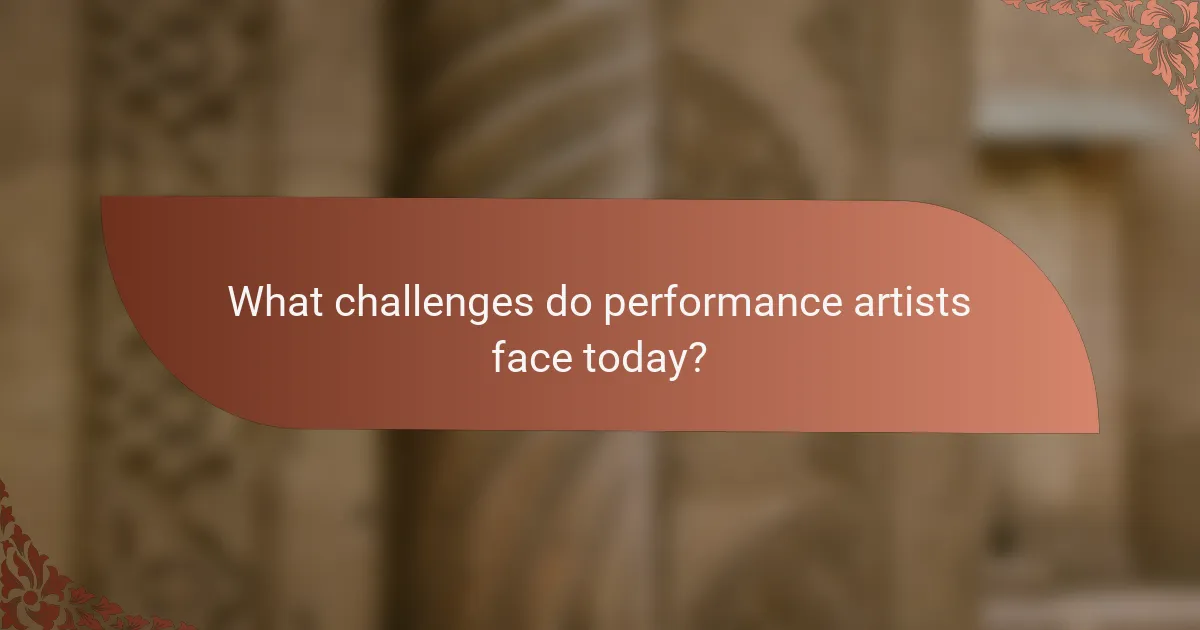
What challenges do performance artists face today?
Performance artists today face various challenges, including funding limitations, audience engagement, and the impact of digital media. Funding remains a significant issue, as many artists rely on grants and sponsorships that are increasingly competitive. Audience engagement has shifted due to the rise of social media, making it harder for artists to connect deeply with viewers in live settings. Additionally, the proliferation of digital platforms has altered the landscape, forcing artists to adapt their work for online consumption while maintaining authenticity. The unique attribute of performance art is its ephemeral nature, which can be at odds with the demand for recorded content. These challenges require artists to innovate continually while navigating a complex cultural environment.
How do funding and sponsorship affect performance art projects?
Funding and sponsorship significantly enhance performance art projects by providing essential resources and visibility. Financial support allows artists to experiment with innovative techniques and reach broader audiences. Sponsorship can also create partnerships that foster community engagement, amplifying the project’s impact. In contemporary contexts, successful funding often leads to increased artistic freedom and the ability to explore complex themes, enriching the overall performance experience.
What are common misconceptions about performance art?
Many people mistakenly believe performance art lacks structure and is purely spontaneous. In reality, it often involves meticulous planning and rehearsals. Another misconception is that performance art is only for elite audiences; it is designed to engage diverse viewers. Some think performance art is solely about shock value, while it frequently aims to provoke thought and discussion. Additionally, many assume performance art is a modern phenomenon, but it has historical roots dating back to ancient rituals and theater.
How do artists navigate censorship and artistic freedom?
Artists navigate censorship and artistic freedom by employing innovative techniques and drawing on historical contexts. Performance art often serves as a medium for challenging societal norms and political boundaries. Artists utilize symbolism and audience interaction to convey messages that may be censored in other forms. Historical movements, such as Dadaism and Fluxus, demonstrate how artists have historically resisted censorship through subversive practices. Modern interpretations continue this legacy, with artists using digital platforms to reach wider audiences and bypass traditional gatekeepers. This adaptability highlights the unique attribute of performance art as a tool for social commentary and activism.
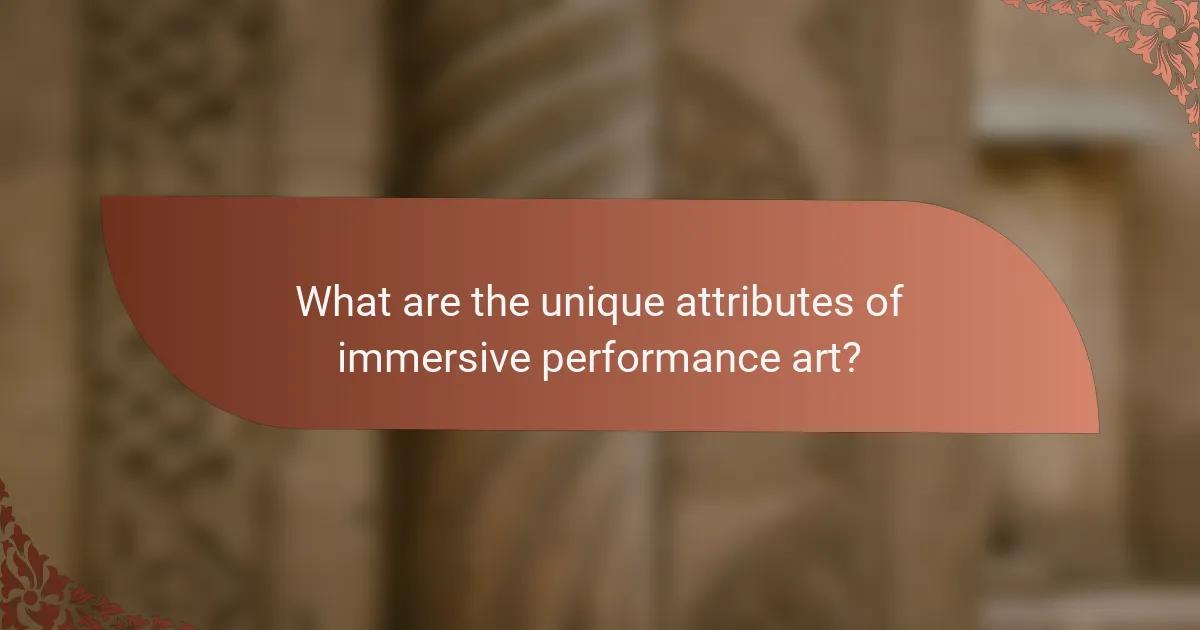
What are the unique attributes of immersive performance art?
Immersive performance art is defined by its unique attributes, including audience participation, multisensory experiences, and site-specificity. These features create an interactive environment that blurs the line between performer and viewer. Immersive performances often utilize technology, such as virtual reality, to enhance engagement. Additionally, they challenge traditional narrative structures, offering a fluid and dynamic experience that evolves with audience interaction.
How does immersive performance art engage the audience differently?
Immersive performance art captivates audiences by creating interactive experiences that foster emotional connections. This art form often breaks the fourth wall, allowing spectators to participate actively, which enhances engagement. Unlike traditional performances, immersive art invites personal interpretation and response, making each experience unique. The use of sensory elements, such as sound, visuals, and tactile interactions, further deepens audience involvement, transforming passive viewers into active participants.
What are notable examples of successful immersive performance art?
Notable examples of successful immersive performance art include “Sleep No More,” “The Encounter,” and “The Obliteration Room.” Each piece engages audiences in unique ways, transforming traditional theater into interactive experiences. “Sleep No More” combines elements of film and theater in a noir-inspired narrative, allowing viewers to explore a multi-layered environment. “The Encounter” utilizes sound design and technology to create an intimate storytelling experience. “The Obliteration Room” invites participants to contribute by adding color to a completely white space, evolving the artwork through interaction. These examples illustrate how immersive performance art blurs the lines between artist and audience, creating memorable experiences.
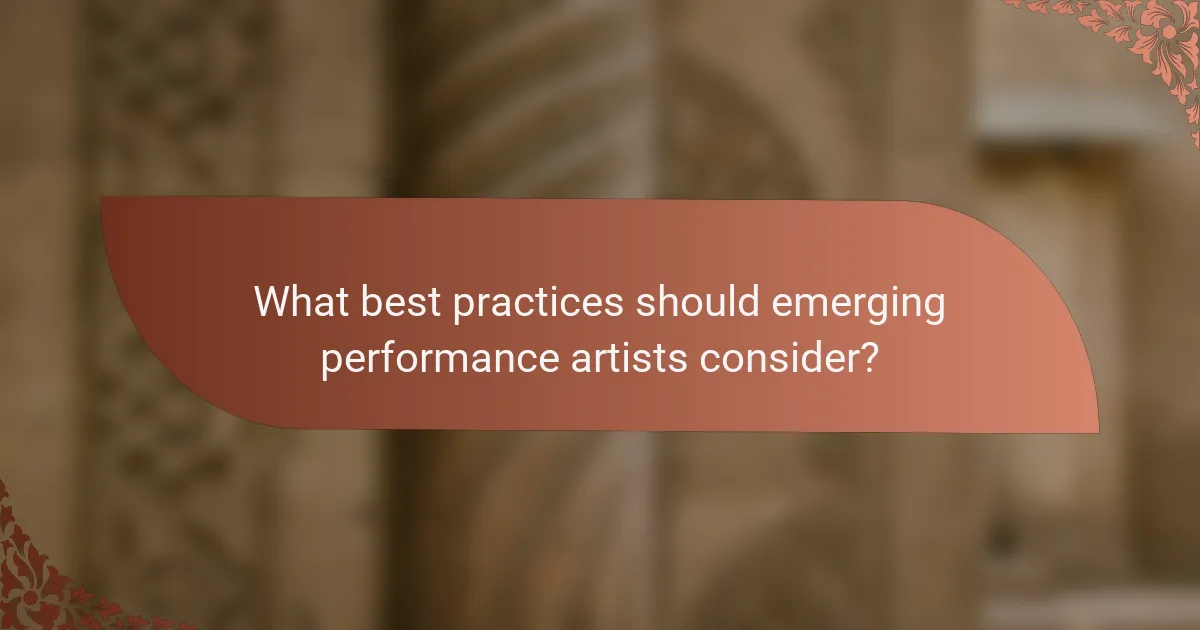
What best practices should emerging performance artists consider?
Emerging performance artists should focus on authenticity, audience engagement, and continuous experimentation. Authenticity fosters a genuine connection, while engaging the audience creates a memorable experience. Experimentation allows artists to innovate and evolve their craft.
1. Develop a unique voice that reflects personal experiences.
2. Utilize diverse mediums to enhance storytelling.
3. Seek feedback from peers and audiences to refine performances.
4. Stay informed about contemporary art trends and historical influences.
How can artists effectively market their performance art?
Artists can effectively market their performance art by leveraging social media, engaging with local communities, and collaborating with other artists. Social media platforms allow artists to showcase their work, share behind-the-scenes content, and connect with audiences. Engaging with local communities through workshops or events builds a loyal following and enhances visibility. Collaborating with other artists can expand reach and introduce new audiences to their performances. Each of these strategies fosters a unique connection with potential viewers, enhancing the overall impact of the performance art.
What are the common pitfalls to avoid in performance art?
Common pitfalls in performance art include lack of audience engagement, failure to convey a clear message, neglecting the importance of space and environment, and overcomplicating concepts. Artists should ensure their work resonates with viewers to avoid these issues. Engaging the audience fosters connection and understanding, while clarity enhances the impact of the performance.
How can collaboration enhance performance art projects?
Collaboration significantly enhances performance art projects by fostering creativity and expanding artistic perspectives. Artists working together can combine diverse techniques, enriching the overall experience for audiences. Collaborative efforts often lead to innovative concepts that challenge traditional boundaries of performance art. Additionally, shared resources and skills can improve production quality and provide access to broader networks, ultimately elevating the impact of the project.
